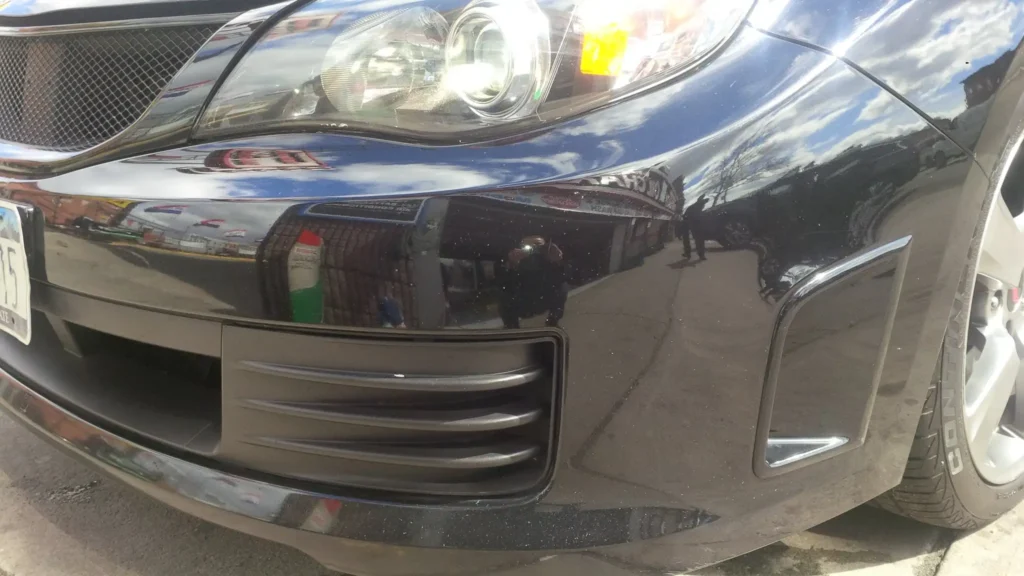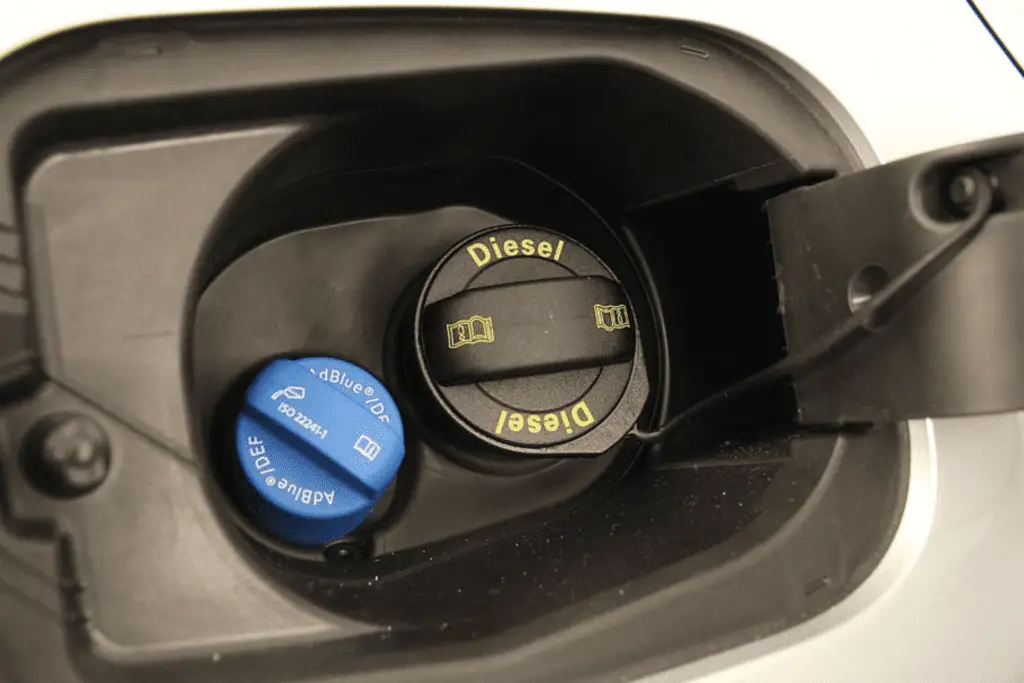Seeing white smoke from AC vents in cars can be alarming. Your first reaction may be to turn off the AC and roll down the windows. But what causes this to happen and how can you fix it?
This comprehensive guide will explore the most common reasons for white smoke from AC vents and provide practical solutions. You can just read on to diagnose the root cause and resolve the issue once and for all.
Main Causes of White Smoke From AC Vents In Car
White smoke coming from the AC vents has a range of possible causes, including:
- Coolant leak in the heater core
- Clogged AC drain tube
- Frozen AC evaporator
- Leaking coolant hoses
- Damaged compressor clutch
- Bad water pump
- Burning smells from electrical shorts
- Moisture buildup inside the system
- Worn-out shaft seals
- Blower motor failure
- Refrigerant leaks
- Humidity and condensation issues
Detecting odd smells, listening for unusual noises, and noting when the smoke appears can help zero in on the culprit. We’ll now explain these common causes in more detail and how to remedy them.
Coolant Leak in the Heater Core
One of the most common reasons for white smoke from the AC vents is a coolant leak in the heater core. The heater core is responsible for providing hot air to the cabin when you switch on the car’s heater.
The heater core is essentially a miniature radiator that carries hot coolant from the engine. If the heater core develops any cracks or holes, it can leak engine coolant into the HVAC system. This gets vaporized into steam when the air blows past it and enters the cabin as white smoke.
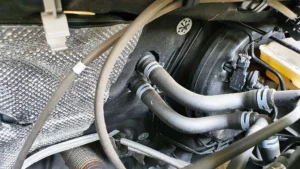
In addition to the white smoke, a coolant leak in the heater core will usually produce a sweet, almost syrupy smell. You may also notice the engine running hotter and coolant levels getting low. Addressing a leaking heater core quickly is important to avoid overheating the engine.
Fixing a leaky heater core:
The heater core is buried deep inside the dashboard, so repairing it requires major dashboard removal. The total repair cost is typically between $400 to $1000. An alternative is using a stop leak product like Blue Devil to seal small leaks and buy some time before needing a full repair.
Replacing the entire heater core assembly is recommended for permanent fixing. Make sure to flush the system thoroughly to avoid future clogging issues.
Clogged AC Drain Tube
All air conditioning systems produce condensation water that needs to drain out of the car. There is usually a plastic drain tube that removes this water from the AC evaporator housing.
If the drain gets clogged with debris, the water has nowhere to go. It will accumulate inside the HVAC system and evaporate into steam when the air blows past. This moisture-laden air then enters the cabin through the vents as white smoke.
The smoke from a clogged drain tube is generally odorless. You may notice the car’s windows fogging up more easily due to the excess humidity as well. Clearing out the blockage in the drain tube is a quick and inexpensive fix.
Unclogging the AC drain:
- Locate the drain tube – usually a 1⁄2” plastic tube near the evaporator housing.
- Try blowing compressed air through the tube to dislodge any debris.
- Use a small wire or pipe cleaner to clear any stubborn obstructions.
- Flush with water if needed.
- Install a small screen filter on the drain exit point to prevent future clogs.
DIY drain unclogging costs less than $10 in materials. A mechanic will charge $40 to $80 to perform the service.
Frozen AC Evaporator
If your AC system is low on refrigerant, the evaporator can start to freeze up when you run the air conditioning. The moisture in the air condenses and freezes on the cold evaporator coils.
When you then switch to air-recirculation mode, the frozen evaporator starts to defrost and turn back into water vapor. This gets blown out as white mist from the AC vents into the cabin.
Frozen evaporators are often caused by small refrigerant leaks in the AC system. The low refrigerant allows ice to form on the coils. Fixing leaks and properly recharging the AC system is key.
Repairing a frozen AC evaporator:
- Identify and repair any refrigerant leaks in the AC system.
- Add UV dye then use a UV light to find leaks.
- Recover any remaining refrigerant and evacuate the system.
- Replace the receiver/drier filter.
- Recharge with new refrigerant to specified capacity.
- Verify AC performance after repairs.
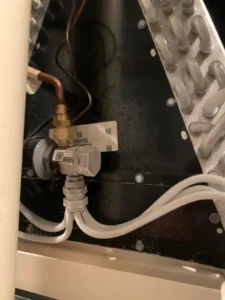
Expect to pay $200 to $350 for professional evaporator freeze repairs. DIY recharging is possible but ensuring the correct refrigerant amount is tricky.
Leaking Coolant Hoses
The various coolant hoses that transport hot engine coolant through the heater core can also start to leak over time. This will release steam with traces of coolant into the HVAC module and enter the cabin as white smoke.
Inspect all rubber heater hoses carefully for any cracks, bulges, or wet spots indicating a leak. Bad hoses should be replaced with equivalents that meet OEM specifications. This prevents overheating issues and coolant leaks.
Replacing leaking coolant hoses:
- Allow the engine to fully cool before inspecting the hoses.
- Locate the source of the coolant leak based on visible damage.
- Drain coolant system if needed to replace hoses.
- Install new hoses and clamps to match OEM parts.
- Refill coolant and bleed all air out of the system.
- Check for leaks and monitor engine temperature.
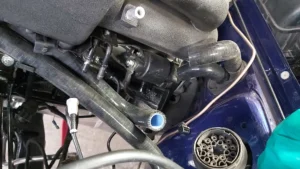
Coolant hose replacement costs around $150 to $300 in labor if done at a shop. DIY is cheaper at $50 to $150 but requires draining and refilling the system properly.
Damaged Compressor Clutch
The AC compressor clutch can become damaged over years of cycling on and off. Common failure modes include worn bearings, loose magnets, and broken clutch coils. This causes sparking and overheating which produces light smoke.
As the compressor clutch continues to degrade, it will release white smoke into the AC system. This then gets blown through the vents when the blower fan is running. Catching clutch issues early prevents major AC compressor damage.
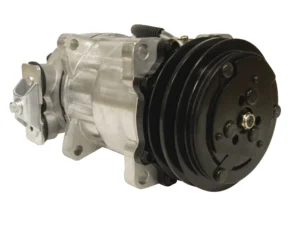
Fixing a damaged AC compressor clutch:
- Listen for squealing noises that indicate worn bearings.
- Check for drag and resistance when spinning the clutch by hand.
- Inspect for broken or cracked magnets around the clutch hub.
- Ensure the electrical connector is clean and tight.
- Replace the entire clutch assembly if worn or damaged.
Compressor clutch replacement costs around $250 to $600 for parts and labor. Avoid Servicing the AC system after a clutch swap.
Bad Water Pump
The water pump circulates engine coolant through the cooling system and heater core. If the pump bearings are worn out or the impeller blades break, the pump can no longer move coolant efficiently.
This lack of circulation allows the heater core to get excessively hot. The heated coolant passing through gets turned into steam. When this enters the HVAC module, it emerges as white smoke from the AC vents.
Catching a bad water pump early on can help avoid overheating and more expensive repairs. Listen for grinding or rattling noises as an early warning.
Replacing a failing water pump:
- Inspect the water pump shaft for play indicating worn bearings.
- Check for leaking coolant around the water pump housing.
- Remove and check pump impeller blades for damage.
- Install new water pump with gasket seal if bearings or impeller are bad.
- Refill the cooling system and bleed out any trapped air.
Water pump replacement averages $350 to $600 for parts and labor. Costs are higher on vehicles where the pump is timing chain driven.
Burning Smells from Electrical Shorts
Electrical issues like damaged wiring, bad connectors, or short circuits can produce light smoke or burning smells. This often happens when electrical components overheat and start melting insulation or plastics.
If the smoke from an electrical short happens to occur near the blower motor or ventilation ducts, it can get drawn inside the cabin. Usually, this smoke is light and only occurs briefly before a fuse blows. However, it indicates an electrical fault that needs diagnosis and repair.
Finding and fixing electrical shorts:
- Sniff inside vents to pinpoint the origin of the burning smell.
- Inspect wiring harnesses for melted spots or bare wires.
- Check all connectors for corrosion, damage, or looseness.
- Replace any damaged wires, looms, or connectors.
- Address shorted circuits causing overheating components.
- Confirm no more smoke before driving again.
Costs to fix electrical shorts vary hugely based on how accessible the damaged wiring is. Plan on at least $200.
Moisture Buildup Inside the System
High humidity levels combined with cold interior temperatures can lead to excessive moisture inside the HVAC system. Just like with a clogged drain tube, this moisture evaporates into steam from the airflow. The steam then enters the cabin as white mist or smoke from the vents.
Preventing moisture buildup involves running the AC/heat at full temperature for 5-10 minutes before turning it down. This reduces humidity entering the vents. Also, make sure the cabin air filter is clean and the AC drain tube is clear.
Removing excess moisture:
- Run fan at max while AC or heat is on high temp.
- Open windows to help vent out interior humidity.
- Use a dehumidifier bag or desiccant packets inside vents.
- Make sure the AC drain tube is clear to remove water.
- Replace the cabin air filter if excessively dirty.
Moisture removal is mostly DIY using the tips above. Deep HVAC cleaning by a mechanic runs $80 to $150 if mold or mildew is present.
Worn Out Shaft Seals
Rotating components inside the AC system have rubber shaft seals to contain refrigerant and oil leakage. If these seals start to crack or wear out, small amounts of oil vapor will enter the AC ducting.
When the blower fan runs, this thin oil vapor gets misted through the vents into the cabin. It appears as faint white smoke due to the tiny oil droplets suspended in the air. Bad shaft seals require identification and replacement by an AC technician.
Replacing worn AC shaft seals:
- Remove AC components to check seals for cracks or swelling.
- Look for small oil deposits indicating seal wear or damage.
- Have the technician replace any damaged seals with equivalent parts.
- Add UV dye and check the system for leaks after reassembly.
- Recharge the system with refrigerant after verifying no leaks.
Expect to pay $200 to $400 for seal replacements on AC components like the compressor or evaporator. Just the cost of refrigerant and labor adds up quickly.
Blower Motor Failure
The blower motor contains brushes, windings, and resistors that can overheat or short out over time. Electrical faults in the motor can produce light smoke or burning smells as insulation melts.
Smoke from a failing blower motor will only occur when it first receives power before any fuses cut out. But it’s a sign the motor needs professional diagnosis and repair or replacement. Don’t continue using it.
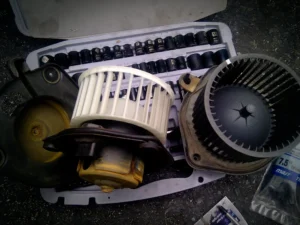
Fixing a burned-out blower motor:
- Remove the glovebox for access to the blower motor.
- Detach the wiring connector and check for any melted spots.
- Test motor windings for open or grounded circuits.
- Inspect brushes and resistors for damage.
- Replace the entire blower motor assembly if faulty.
Blower motor repair or replacement typically costs $200 to $450 for parts and labor. Try applying a voltage to test for failures before condemnation.
Refrigerant Leaks
Refrigerant is the lifeblood of any air conditioning system. If the sealed AC loop develops any leaks, the refrigerant will slowly escape. Low refrigerant reduces cooling performance and efficiency.
One consequence of refrigerant leaks is that moisture in the air condenses more readily on the evaporator coils. This excess condensation evaporates from the airflow as white mist through the vents.
Finding and sealing refrigerant leaks is crucial to prevent AC failure. Small leaks can often be detected through UV dye testing. Major leaks require professional service and repair.
Repairing refrigerant leaks:
- Add UV fluorescent dye to the AC system.
- Operate AC and use UV light to spot dye leakage.
- Tighten fittings or replace leaking pipes/lines as needed.
- Evacuate the system fully and replace the receiver/drier filter.
- Recharge system with precise refrigerant capacity.
Costs for leak repairs vary hugely based on location and parts needing replacement. Budget $200 to $500 on average for minor leaks.
Humidity and Condensation Issues
Very humid outdoor conditions can overload the AC system with moisture. This condenses on the evaporator coils faster than it can drain or evaporate. The excess water vapor then blows through the vents into the cabin.
Using recirculated air instead of fresh air from outside can help reduce intake humidity. Also, make sure the AC drain tube is clear and the cabin filter is clean. This minimizes the chances of interior condensation issues.
Lowering humidity levels:
- Set AC to recirculated air mode when humidity is very high.
- Replace dirty cabin air filter to improve airflow.
- Make sure the AC drain tube is clear and draining properly.
- Use cleaning products to prevent mold and mildew buildup.
- Run heat on max for a while to help dry out the AC system.
There is no “repair” needed for temporary high humidity issues. Operating the climate control properly under those conditions can prevent condensation problems.
How to Diagnose the Exact Cause
With so many potential causes, accurately diagnosing white smoke from the AC vents relies on detecting key symptoms:
- Pay attention to any odors – A sweet antifreeze smell indicates coolant leaks while burning smells point to electrical issues.
- Listen for odd noises – Rattling or grinding could be a bad water pump or worn compressor clutch.
- Note when smoke appears – Smoke only when heat is on? Likely a heater core or coolant hose leak. Only with AC? Look at the evaporator or seals.
- Check other symptoms – Do you see leaks under the hood or dashboard? Is AC performance weak? Any electrical glitches? Take note of anything unusual.
- Consider humidity and temperatures – Very humid or damp conditions can exacerbate condensation problems and clogged drains.
By combining these clues with targeted inspections, you can zero in on why white smoke is coming from the vents. Identifying the root cause is the key first step before attempting any repairs.
Preventing Repeat Occurrences
Once you’ve fixed the issue causing white smoke from the AC vents, take actions to prevent it from happening again:
- Maintain the AC system – Evacuate and recharge the refrigerant every 2-3 years to prevent leaks.
- Inspect coolant hoses – Replace any heated or cracked hoses before they leak.
- Clear drains frequently – Blow compressed air through the AC drain tube to keep it open.
- Change cabin filter – Replace every 10-15k miles or once a year minimum.
- Fix drips and leaks – Address any external fluid leaks right away to avoid problems.
- Use recirculated air – This reduces humidity entering the system on damp days.
- Monitor the car for odd smells or noises – Be alert for any unusual symptoms or issues.
With diligent preventative maintenance and awareness of potential causes, you can help keep your AC system blowing clean, comfortable air for years to come.
Frequently Asked Questions
Why does white smoke come out of my car AC?
The most common causes of white smoke from car AC vents are coolant leaks in the heater core, clogged drain tubes, frozen evaporators, electrical issues, and high humidity. Identifying distinguishing smells or when the smoke appears can help diagnose the exact reason.
Why is white smoke coming out of my car’s AC vent?
White smoke from the AC vents is usually caused by problems like leaking coolant, moisture buildup inside the system, worn seals allowing oil mist through, and electrical faults producing burning smells. The smoke may only occur when using AC or heat, pointing to specific components.
Why is steam coming out of my car vents?
Steam from the vents is typically due to water vapor condensing and entering the airflow. Causes include a clogged AC drain, frozen evaporator, leaking coolant reaching high temperatures, and extreme humidity overloading the AC system.
